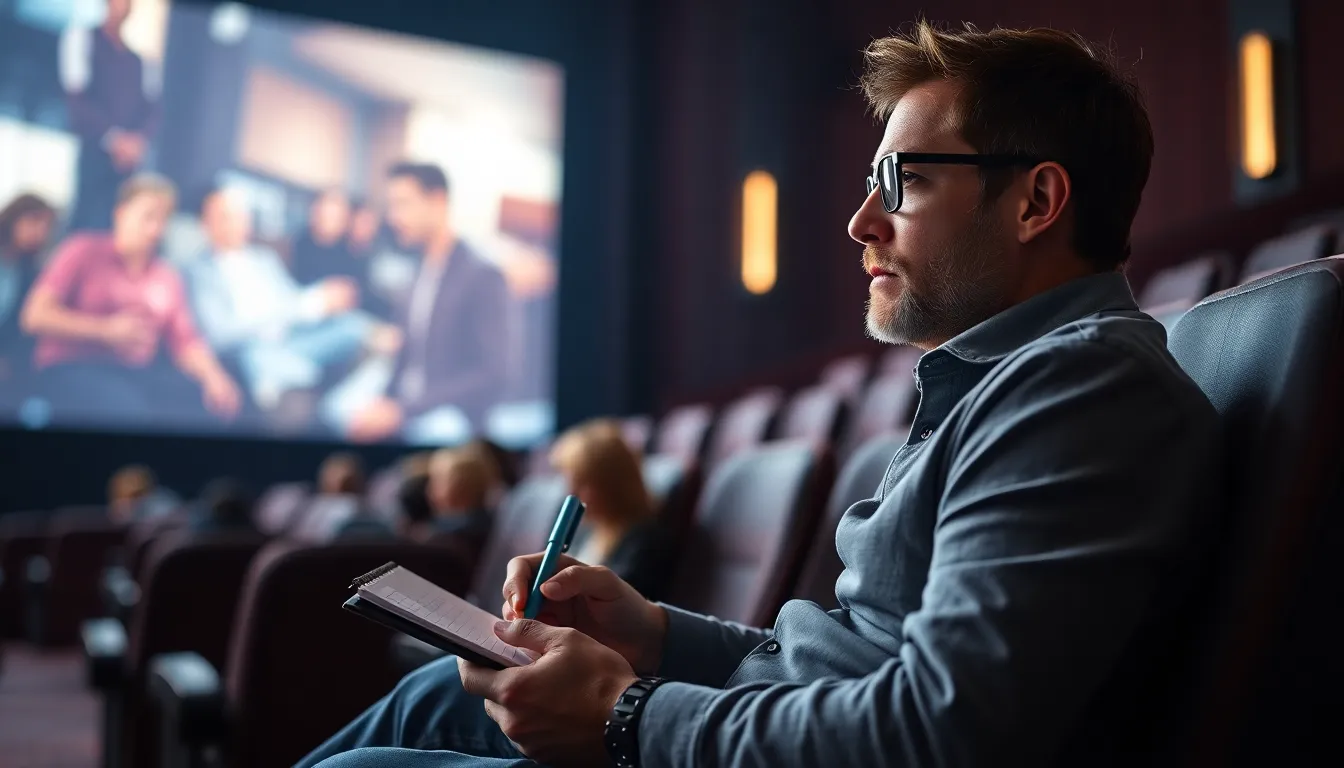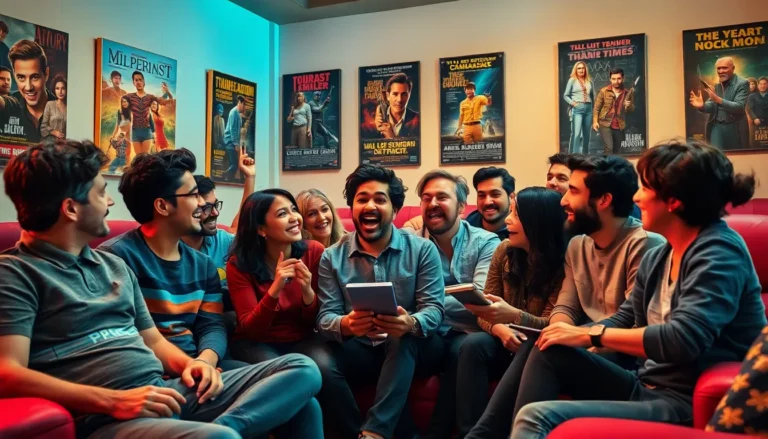In a world overflowing with films, navigating the cinematic landscape can feel like trying to find a needle in a haystack—if that needle were a blockbuster and the haystack were a mountain of mediocre rom-coms. Enter the movie critique, the unsung hero armed with popcorn and a discerning eye. They sift through the celluloid chaos, offering insights that can elevate a viewer’s experience from “meh” to “wow.”
Table of Contents
ToggleUnderstanding Movie Critique
Movie critique plays a crucial role in film appreciation and analysis. It involves a systematic evaluation of films to offer insights and opinions on various aspects such as direction, acting, cinematography, and narrative.
Definition of Movie Critique
Movie critique refers to the process of analyzing films to provide an informed opinion about their merits and shortcomings. Critics assess elements like character development, plot coherence, and visual style. Reviews can vary in tone, from analytical to personal, reflecting the critic’s perspective on the film’s effectiveness. Comprehensive critiques often include a balanced view of both positives and negatives to give readers a fuller understanding of the film.
Importance of Movie Critique
Movie critique serves as a valuable resource for audiences seeking quality films. Critics highlight noteworthy films and help potential viewers identify which titles merit their time. By dissecting various cinematic elements, critiques enhance the viewing experience and prompt discussions about themes or techniques. Engagement with critiques encourages viewers to think critically, fostering a deeper appreciation for cinema as an art form. Moreover, informed critiques can impact a film’s success, influencing box office performance and audience reception.
Components of a Movie Critique

A movie critique encompasses various elements that together create a comprehensive analysis of a film’s quality. Understanding these components aids both critics and audiences in grasping the film’s strengths and weaknesses.
Plot Analysis
Plot analysis examines the storyline’s structure and coherence. Critics evaluate plot progression, pacing, and the effectiveness of twists. They identify whether the narrative engages viewers and maintains their interest. Clear storytelling enhances audience connection, while convoluted plots may confuse. This assessment often highlights thematic elements and messages conveyed throughout the film.
Character Development
Character development focuses on how characters evolve and resonate. Critics analyze depth, motivations, and relationships among characters. Strong character arcs facilitate audience investment, while poorly developed characters can detract from the overall experience. Observing interactions reveals how well actors portray emotions and complexities. Analyzing characters helps determine if their journeys contribute meaningfully to the plot.
Cinematography and Visuals
Cinematography and visuals play a crucial role in shaping a film’s aesthetic. Critics assess camera angles, lighting, and shot composition to enhance storytelling. Visuals often establish mood and tone, affecting audience engagement. Choices such as color palettes and visual effects influence perceptions of realism and creativity. Analyzing these aspects helps determine their contribution to the film’s overall impact.
Sound and Music
Sound and music dramatically enhance a movie’s emotional landscape. Critics examine score composition, background effects, and sound design. Effective audio elevates tension or evokes nostalgia. Music often underscores key moments, influencing audience reactions. Assessing sound helps identify whether it complements visual storytelling and reinforces themes, enhancing the viewer’s overall experience.
Different Approaches to Movie Critique
Movie critique encompasses various perspectives, each offering unique insights into the cinematic experience. Understanding these approaches enhances appreciation for film analysis.
Personal vs. Professional Critiques
Personal critiques stem from individual preferences and experiences. They often reflect emotional reactions and personal interpretations of a film. Professional critiques prioritize technical aspects, structure, and artistic values. Critics with professional backgrounds evaluate movies based on established criteria, providing informed insights. While both forms of critique can be valid, personal critiques resonate with viewers seeking relatable connections. In contrast, professional critiques aim to guide audiences toward a more rigorous understanding of a film’s merits. This balance enriches discussions surrounding film.
The Role of Subjectivity in Critique
Subjectivity plays a crucial role in movie critique. Every viewer brings unique experiences and cultural backgrounds to their interpretations. Individual responses to themes, characters, and plots often differ significantly. Some critiques may focus on emotional impact, while others may emphasize analytical elements. Personal biases can influence how one evaluates a film’s success or failure. Critics recognize that their assessments reflect subjective experiences. Hence, audiences benefit from considering multiple critiques, gaining a well-rounded view of a film. Embracing subjectivity fosters diverse opinions, contributing to a richer dialogue within the filmmaking community.
Examples of Notable Movie Critiques
Notable movie critiques offer valuable insights into both films and the filmmaking process. They combine expert analysis with audience perspectives, shaping how viewers perceive cinema.
Critiques from Renowned Film Critics
Renowned film critics like Roger Ebert and Pauline Kael have shaped the landscape of movie critique. Ebert’s reviews often combined personal reflections with detailed analysis, making his critiques relatable and insightful. Kael’s passionate style emphasized emotional reactions, highlighting the importance of viewer experience. Critics of this caliber provide authority and context for audiences navigating complex narratives and artistic choices, enriching the conversation around film.
Audience Reviews and Their Impact
Audience reviews contribute significantly to a film’s reception. These critiques reflect diverse opinions shaped by individual experiences, cultural backgrounds, and personal preferences. Platforms like Rotten Tomatoes and IMDb aggregate viewer feedback, providing a busier platform for the collective voice of the audience. Audience reactions can elevate underrated films or diminish the impact of blockbusters. This collective input fosters dialogue and encourages filmmakers to consider the audience’s perspective in future projects.
Navigating the vast sea of films can be daunting but movie critiques serve as invaluable tools for audiences. They not only highlight the strengths and weaknesses of films but also enrich the viewing experience by providing deeper insights into storytelling and artistic choices.
Critics play a pivotal role in shaping perceptions and guiding viewers toward quality cinema. As audiences engage with diverse critiques they cultivate a richer understanding of film as an art form. This ongoing dialogue between critics and viewers fosters a vibrant cinematic community that celebrates creativity and innovation in filmmaking.




